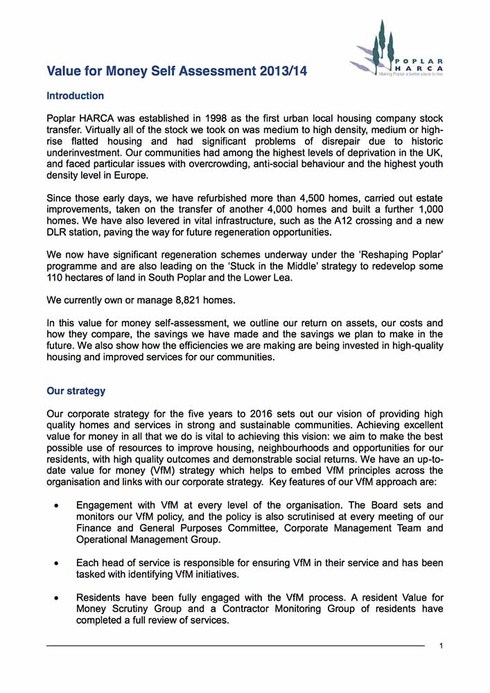
p.2-5
Return on assets Since our earliest days, robust asset management has been vital to our work. This has involved:
Risk based approach
We take a risk based approach to ensure we achieve the desired return on assets within our financial framework. For example, we work in partnership with residential developers using land sale and barter arrangements, which means the risk is carried by the developers. We insist on overage clauses, but there is no underage. We therefore protect ourselves financially from any development losses, but share in development gains. We could take more risk and potentially make a higher financial return. However the priority is to ensure the area is regenerated and we need to ensure that that we can continue with this work in the future.
We do not include any overages in our business plan. We do include conservative assumptions for shared ownership sales and a cash inflow from the Balfron Tower redevelopment. To test financial stability, we run a sensitivity of a 20% fall in shared ownership sales prices and removed all cash inflow from Balfron to ensure we are operating well within our financial framework and funder’s covenants.
Examples of our success in maximising the return on our assets:
The redevelopment of the Aberfeldy Estate, which is now onsite, where we are replacing 297 existing homes with 1,176 new homes, of which 828 are for sale, 158 are for private rent, 170 are for affordable rent and 20 are for shared ownership. We are increasing the density of the estate from an existing 160 habitable rooms per hectare to 527, increasing the value of the land and our stock holding without the need to buy additional land. On the first phase of Aberfeldy, we have been generating an average sales value of £412 per square metre (psqm) against an appraisal allowance of £387 psqm.
Converting the Grade 2 listed Balfron Tower from a social rented block to all private sales. The red book valuation of Balfron Tower using EUV–SH is negative (£4,030,000). By changing the tenure to private sale we anticipate that the project will generate a positive NPV and reduce financial risk for Poplar HARCA.
We have secured overage clauses in contracts to ensure that we benefit from any upturn in the market. This strategy is expected to generate nearly £4m over two years including £1m for the Panoramic building, £500,000 for Carron Close, £1m for Bartlett Park and more than £1m for Tweed House.
Our 'Urban Living' initiative in partnership with Bellway Homes and Telford Homes identifies small unused sites or low density bedsit blocks to be replaced with higher density mixed tenure schemes. This has generated new affordable housing and land receipts for Poplar HARCA. In 2013/14 the Urban Living programme generated 39 new homes and we expect overage payments once work has been completed.
Work to identify new funding sources to increase net present values and return on investment. These include a project with DCLG and the GLA to identify potential new loan funds.
Examples of our success in maximising the return on our assets:
Converting the Grade 2 listed Balfron Tower from a social rented block to all private sales. The red book valuation of Balfron Tower using EUV–SH is negative (£4,030,000). By changing the tenure to private sale we anticipate that the project will generate a positive NPV and reduce financial risk for Poplar HARCA.